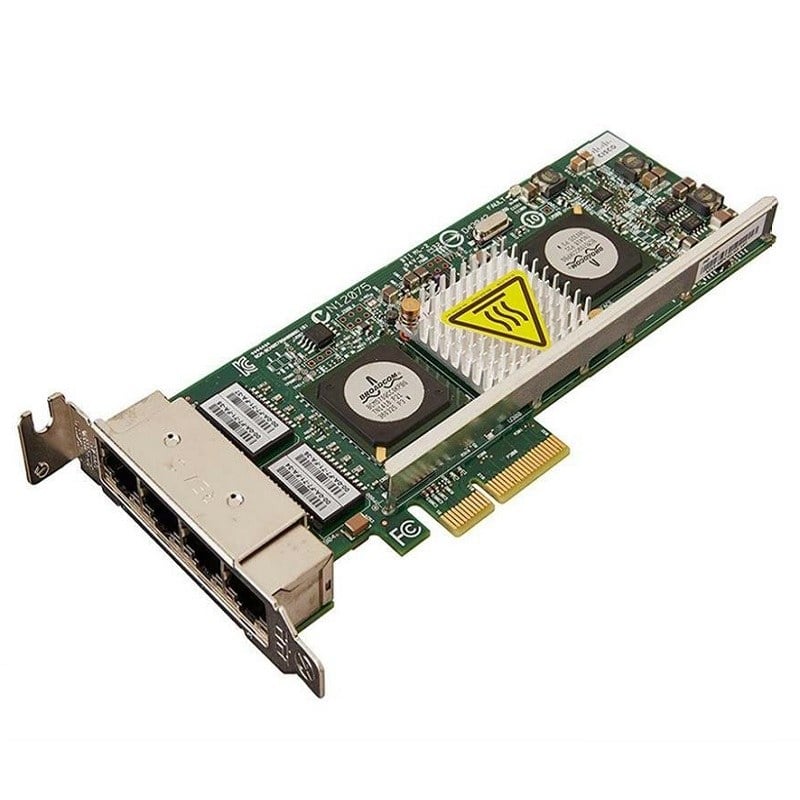Description
Security Features and Measures
The HPE Ethernet 1GB 4-port 366m Adapter provides several security features and measures to ensure the security of network data and devices, including:
- Advanced Encryption Standard (AES): The adapter supports Advanced Encryption Standard (AES), a widely-used encryption algorithm that provides secure data transmission over the network. AES encryption helps to prevent unauthorized access to sensitive network data and ensures the confidentiality and integrity of data transmissions.
- Secure Boot: The adapter supports Secure Boot, a security feature that ensures the adapter’s firmware is authentic and has not been tampered with. Secure Boot helps to prevent the installation of unauthorized firmware or malware on the adapter, enhancing the overall security of the network.
- Network Access Control (NAC): The adapter supports Network Access Control (NAC), a security framework that enables network administrators to enforce security policies and control access to the network. NAC helps to prevent unauthorized access to the network and ensures that only authorized devices and users can access the network resources.
- VLAN Support: The adapter supports Virtual LAN (VLAN) technology, which enables network administrators to segment the network into multiple virtual networks. VLANs help to improve network security by isolating network traffic and preventing unauthorized access to sensitive network resources.
- MAC Address Filtering: The adapter supports MAC address filtering, a security feature that enables network administrators to control access to the network based on the MAC addresses of network devices. MAC address filtering helps to prevent unauthorized access to the network and ensures that only authorized devices can access the network resources.
Compatibility with Network Devices
The HPE Ethernet 1GB 4-port 366m Adapter is designed to be compatible with a wide range of network devices, including servers, switches, and storage systems. The adapter supports industry-standard interfaces, such as PCIe, and is compatible with a variety of operating systems, including Windows, Linux, and VMware.
The adapter is compatible with a range of HPE ProLiant Gen9 and Gen10 servers, including BladeSystem c-Class enclosures and HPE Synergy Compute Modules. The adapter is also compatible with HPE FlexFabric and FlexNetwork switches, enabling seamless integration with existing network infrastructure.
In addition, the adapter is compatible with a range of storage systems, including HPE 3PAR, HPE StoreVirtual, and HPE StoreServ, providing high-speed connectivity to storage resources and enabling fast data transfers.
Effective Switch Configuration and Organization
Effective switch configuration and organization is crucial for ensuring optimal network performance, security, and reliability. Here are some tips for configuring and organizing switches in a network:
- Develop a comprehensive network diagram: Before configuring switches, it’s essential to have a comprehensive network diagram that outlines the network’s topology, including the location of switches, routers, servers, and other network devices.
- Plan VLANs: Virtual Local Area Networks (VLANs) are used to segment the network into smaller logical groups, providing enhanced security and performance. Plan VLANs based on the network’s requirements and create them on the switches.
- Configure Spanning Tree Protocol (STP): STP is used to prevent network loops, which can cause network outages. Configure STP on switches to ensure that there are no loops in the network.
- Implement Quality of Service (QoS): QoS is used to prioritize network traffic based on the type of data being transmitted. For example, real-time applications like video conferencing require high priority, while file transfers can have lower priority. Configure QoS on switches to ensure that the network’s critical applications receive the necessary bandwidth.
- Enable Port Security: Port security is used to prevent unauthorized access to the network by limiting the number of devices that can connect to a switch port. Configure port security on switches to ensure that only authorized devices can connect to the network.
- Use Link Aggregation Control Protocol (LACP): LACP is used to bundle multiple physical links between switches to increase bandwidth and provide redundancy. Configure LACP on switches to increase network availability and performance.
- Monitor switch performance: It’s essential to monitor switch performance regularly to detect any issues and ensure that the network is functioning correctly. Use network monitoring tools to monitor switch performance and identify any potential issues.
General Information
- Manufacturer: HPE
- MPN: 615729-B21
- Spare Part Number: 616010-001
- Type: Network adapter-4 ports
- SKU: 615729-B21
- Interface (Bus) Type: PCI Express 2.1 x4
- PCI Specification Revision: PCIe 2.1
Networking
- Connectivity Technology: Wired
- Data Link Protocol: GigE
- Data Transfer Rate: 1 Gbps
Features
- Fault tolerance, load balancing, Jumbo Frames support, PXE support, Large Send Offload (LSO)
- Compliant Standards: IEEE 802.3, IEEE 802.1Q, IEEE 802.1p, IEEE 802.3x, IEEE 802.3ad (LACP), IEEE 802.1as
Processor/Memory
- Processor: 1 x I350 – Intel
Miscellaneous
- Compliant Standards: FCC Class A certified, UL, UL 60950, FCC CFR47 Part 15, WEEE, RoHS
System Requirements
- OS Required: SuSE Linux Enterprise Server, Microsoft Windows Server 2008, Microsoft Windows HPC Server 2008, Oracle Solaris 10, Red Hat Enterprise Linux 6.1, Red Hat Enterprise Linux 5.7, Citrix XenServer 6.0, VMware ESXi 4.1 update 2, VMware ESXi 5.0 update 1, VMware ESX 4.1 update 2
Environmental Parameters
- Min Operating Temperature: 50 °F
- Max Operating Temperature: 95 °F
- Humidity Range Operating: 10 – 90% (non-condensing)
Compatibility Information
- HP ProLiant BL420c G8 G9 (Gen8 Gen9) BL460c G8 G9 (Gen8 Gen9) BL465c G8 G9 (Gen8 Gen9)











